As an Amazon Associate KitchenwareSets.com earns from qualifying purchases.
9 Genius Kitchen Island Seating Designs To Copy Now
Craving a kitchen that feels more like the true heart of your home? You’re not alone. So many of us have kitchens that are functional for cooking but fall short when it comes to gathering, connecting, and making memories. Your current layout might feel isolating, with no place for kids to do homework or for friends to chat with you while you prep dinner.
You need more than just extra counter space; you need a central hub. A place that effortlessly blends the utility of a workspace with the warmth of a dining table. The problem is finding a design that fits your space, matches your style, and meets your family’s needs without feeling bulky or out of place. It’s easy to get lost in a sea of generic ideas that don’t solve your specific challenges.
A well-designed kitchen island with seating is the ultimate solution. It transforms your space by adding a functional food prep area, ample storage, and a casual dining spot. It creates a natural gathering point, making the kitchen the true social hub of your home for family and guests alike. We’ve analyzed countless award-winning designs and consulted expert kitchen planners to distill the most impactful island seating concepts for 2025. Get ready to find the perfect design to copy now.
Craving a Kitchen Hub That’s Both Stylish and Social?
A well-designed kitchen island with seating transforms your space by adding a functional food prep area, ample storage, and a casual dining spot. It creates a natural gathering point, making the kitchen the true social hub of your home for family and guests alike. This single piece of furniture can solve multiple problems, from a lack of counter space to the need for a casual place for morning coffee or weeknight dinners. It elegantly anchors the room, serving as both a kitchen focal point and a highly functional workhorse.
Key Considerations Before You Choose Your Design
Before you fall in love with a specific look, it’s crucial to assess your space, primary function, and aesthetic goals. Based on guidelines from the National Kitchen & Bath Association (NKBA), ensuring proper clearance is the first step to a functional design. Taking the time to plan these key elements will ensure your island is a perfect fit for your home and lifestyle.
- Space & Dimensions: For a kitchen island with seating, allow at least 36-42 inches of clearance on all sides for traffic flow. This ensures you maintain a safe and efficient kitchen work triangle between your sink, stove, and refrigerator. For seating comfort, plan for a minimum of 24 inches of width per person and 12-15 inches of clear knee space under the countertop overhang.
- Primary Function: What is the main job of your island? Is it primarily for food prep, requiring a durable surface and maybe a prep sink? Is it a storage workhorse, needing deep drawers and cabinets? Or is it mainly a social spot for dining and homework, where comfortable seating is the top priority? Defining its role will guide your design choices.
- Aesthetic Harmony: Your island should complement, not compete with, the rest of your kitchen. Consider the materials for your countertop—durable options like quartz and granite are popular, while butcher block adds warmth. Think about island lighting; pendant lights are a classic choice for providing both task lighting and a design statement. Finally, decide if you want the island to match your existing cabinets or stand out with a contrasting color.
9 Genius Kitchen Island Seating Designs To Copy Now
Ready for some real inspiration? We’ve curated nine incredible kitchen island ideas with seating that go beyond the basics. Each design is selected for its blend of aesthetic appeal and real-world functionality, inspired by top interior designers and popular home renovation trends for 2025. Whether you have a sprawling open-concept area or a cozy, small kitchen, you’ll find a solution here that sparks your imagination and fits your needs.
1. The Multi-Level Entertainer
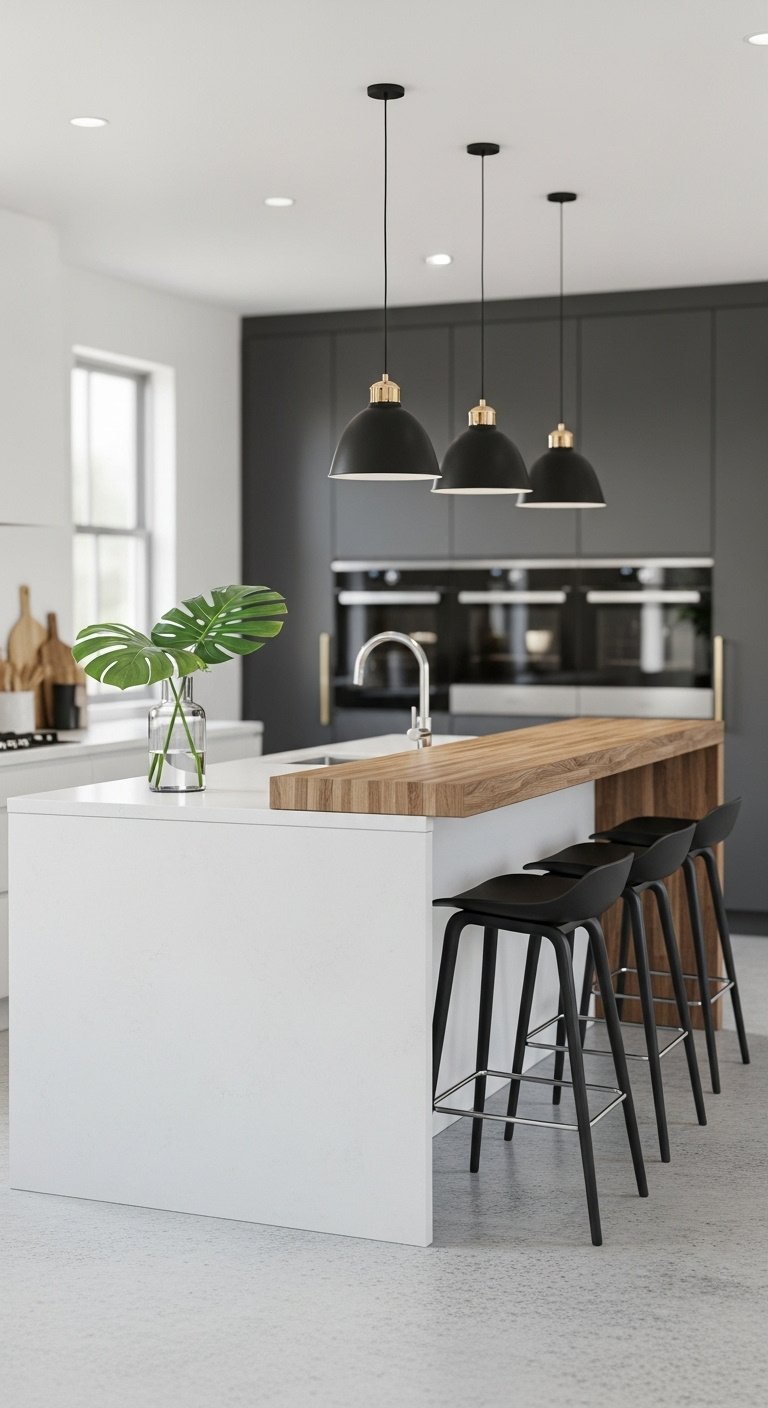
A multi-level island is the perfect solution for creating distinct zones for cooking and socializing. By having a lower, counter-height surface (36 inches) for prep work and a raised, bar-height level (42 inches) for seating, you can keep guests out of your immediate workspace while still encouraging conversation. This two-tier design adds architectural interest and is ideal for entertaining.
- Materials Needed: Cabinet base, countertop material for prep level (e.g., quartz), countertop material for seating level (e.g., butcher block), support brackets, bar stools.
- Step-by-Step Directions:
- Design the island base, ensuring the section for the raised bar has adequate support.
- Install the lower, counter-height (typically 36 inches) countertop for the primary workspace.
- Install strong support brackets for the raised tier. The bar height level should be around 42 inches.
- Secure the bar-height countertop onto the brackets.
- Choose bar stools (with a seat height around 30 inches) that allow for comfortable legroom under the 42-inch high counter.
Pro-Tip: Integrating electrical outlets with USB ports under the lip of the bar-height counter is a small upgrade that adds immense convenience for guests.
Pin this clever two-tier design to your ‘Dream Kitchen’ board!
2. The Sleek Waterfall Edge Wonder
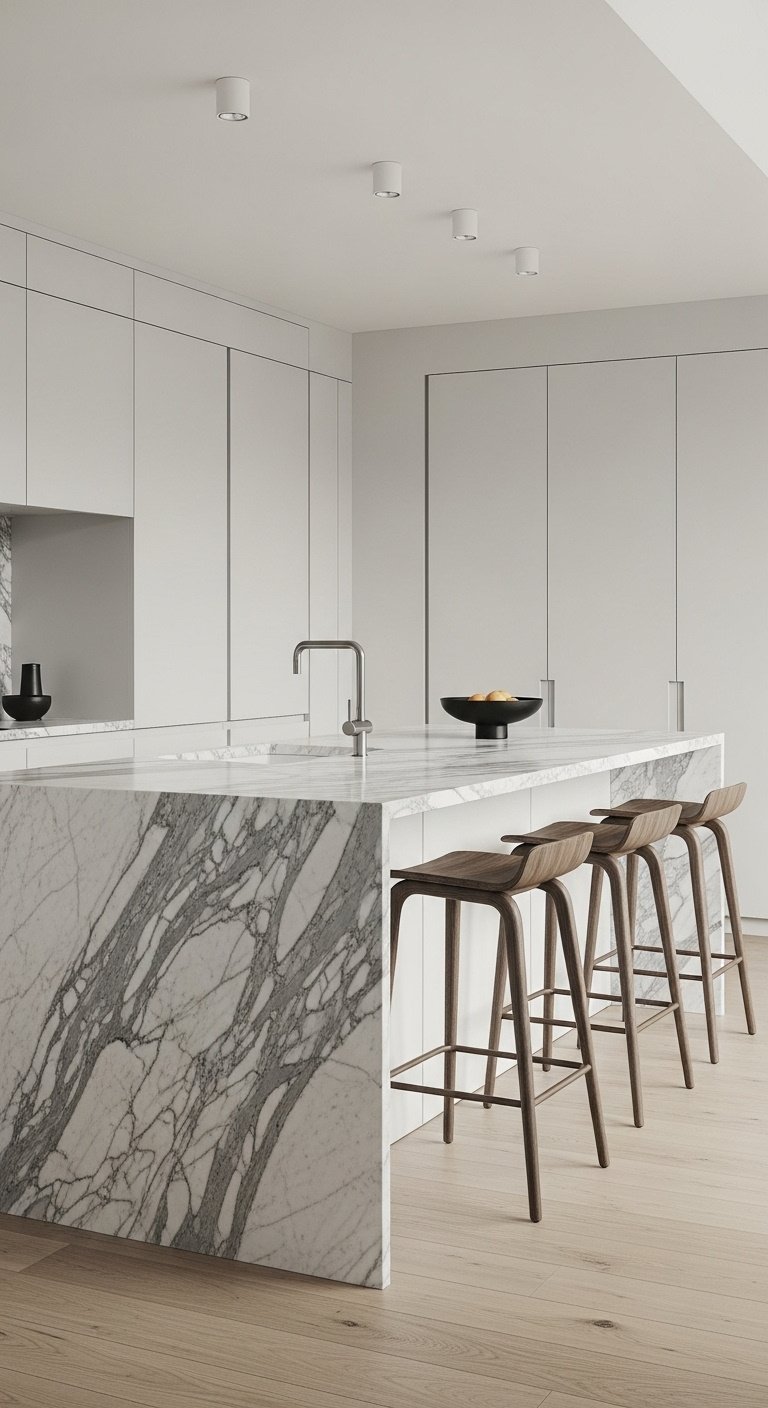
For a dramatic, high-end statement, a waterfall island edge creates a continuous flow of material from the countertop down to the floor. This design turns your island into a sculptural centerpiece, perfect for modern and minimalist kitchen designs. Materials like marble or quartz with bold veining are especially stunning, as the pattern appears to cascade over the sides.
- Materials Needed: Custom-fabricated countertop slab (marble, quartz, or quartzite work best), sturdy cabinet base, minimalist bar stools.
- Step-by-Step Directions:
- Work with a professional stone fabricator. This is not a DIY-friendly project due to the weight and precision required.
- Select a slab with veining you love, as this pattern will be the main feature.
- The fabricator will measure your island base and cut the stone with precise 45-degree mitered edges.
- The top piece and two side “waterfall” pieces are then professionally installed and bonded to create a seamless look.
- Pair with backless stools that can tuck completely underneath to maintain the clean lines.
Lesson Learned: When choosing a stone, ask the fabricator to show you a digital layout of how the veins will “wrap” around the edge. This ensures the pattern flows naturally and avoids awkward cuts.
Love this modern look? Save it for your renovation inspiration!
3. The Small-Space Mobile Solution
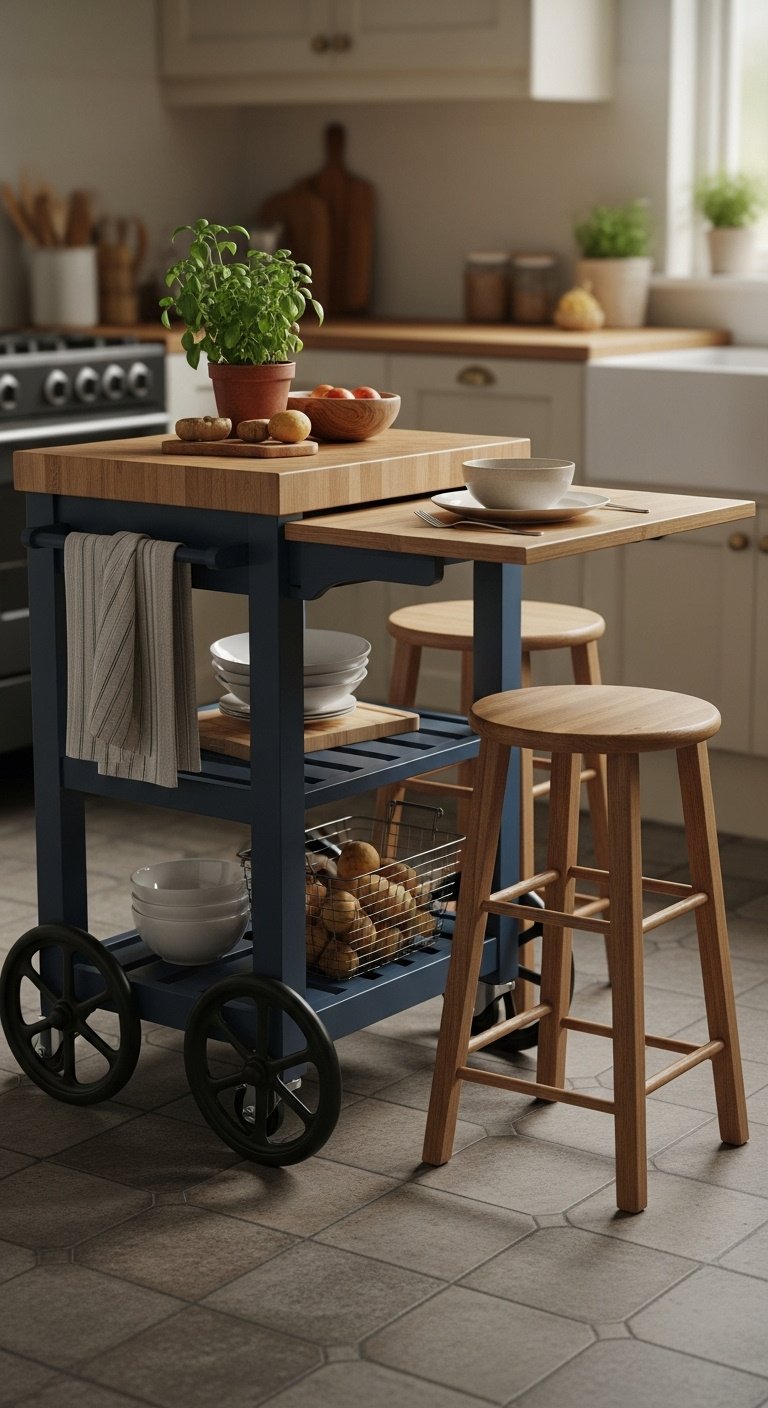
If you think your kitchen is too small for an island, think again. A kitchen island on wheels, or a mobile cart, offers incredible flexibility and function. You can roll it into the center of the kitchen for extra prep space when you need it, and push it against a wall to serve as a breakfast bar or coffee station when you don’t. Look for models with a drop-leaf extension to create an instant dining spot.
- Materials Needed: Pre-made kitchen cart or materials to build one (wood, screws), heavy-duty locking caster wheels, drop-leaf hardware, stools that fit the height.
- Step-by-Step Directions:
- Choose a kitchen cart that fits your kitchen’s narrowest dimension, ensuring it can be moved easily.
- If buying, look for one with locking wheels for stability during use.
- For a seating option, select a cart with a built-in drop-leaf or overhang on one side.
- Pair with saddle stools or other narrow stools that can be easily stored when not in use.
- Utilize any built-in shelving or drawers for essential, easy-to-grab items.
Pro-Tip: Measure your doorways and hallways before buying a mobile island. The flexibility is lost if you can’t easily move it to another room for entertaining.
Perfect for small kitchens! Share this flexible idea with a friend.
4. The Integrated Dining Table Hybrid

This all-in-one design combines a standard-height kitchen island with a lower, table-height extension for dining. It’s the perfect solution for open-concept layouts or for homes without a formal dining room. This hybrid approach allows you to use comfortable, standard dining chairs instead of bar stools, making it ideal for longer meals and family gatherings.
- Materials Needed: Cabinet base for island portion, countertop material (e.g., quartz), wood or material for table portion, dining chairs.
- Step-by-Step Directions:
- Design the island so that the cabinet base stops, allowing for the table extension.
- The island section should be standard counter height (36 inches).
- The attached table should be standard dining table height (28-30 inches).
- Ensure the connection point is well-supported, either with a sturdy leg at the far end of the table or a robust connection to the island base.
- This design allows for the use of more comfortable, standard dining chairs (with an 18-inch seat height) instead of bar stools.
Pro-Tip: Using a different material for the table portion (like wood) versus the island top (like stone) clearly defines the two zones and adds significant visual interest.
Save this all-in-one solution to your ‘Smart Design’ board!
5. The Storage-Maximizing Powerhouse
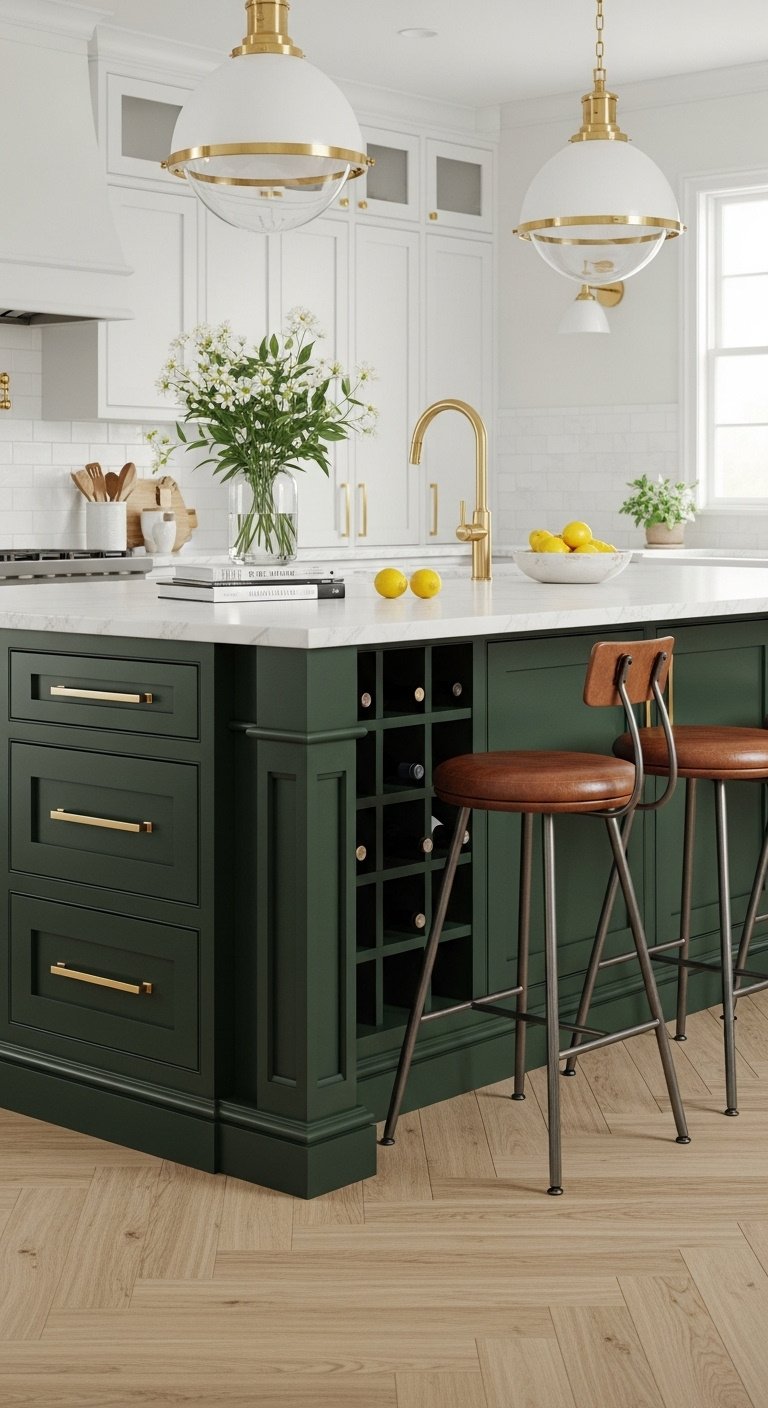
An island can be your kitchen’s best storage asset. This design cleverly integrates storage on all sides without sacrificing seating. The “work” side can feature deep drawers for pots and pans, while the ends can house a wine rack or open shelving for cookbooks. Even the seating side can incorporate shallow, 12-inch-deep cabinets for storing less-used items, all while leaving plenty of knee room.
- Materials Needed: Stock or custom cabinetry, drawer slides, cabinet doors, hardware, countertop material, stools.
- Step-by-Step Directions:
- Plan the layout of your island based on your storage needs. Place frequently used items in drawers on the “work” side.
- Utilize the ends of the island for specialized storage like a wine rack, vertical tray dividers, or a small bookshelf for cookbooks.
- On the seating side, use shallow cabinets (around 12-15 inches deep) to store less-used items like seasonal platters or small appliances. This still allows for adequate knee space.
- Ensure your countertop has a 12-15 inch overhang on the seating side to create a comfortable breakfast bar.
Pro-Tip: Opt for full-extension drawer slides. They allow you to see and reach everything inside, even at the very back, making your storage far more efficient.
Need more storage? Pin this genius island idea now!
6. The Curved Conversation Starter
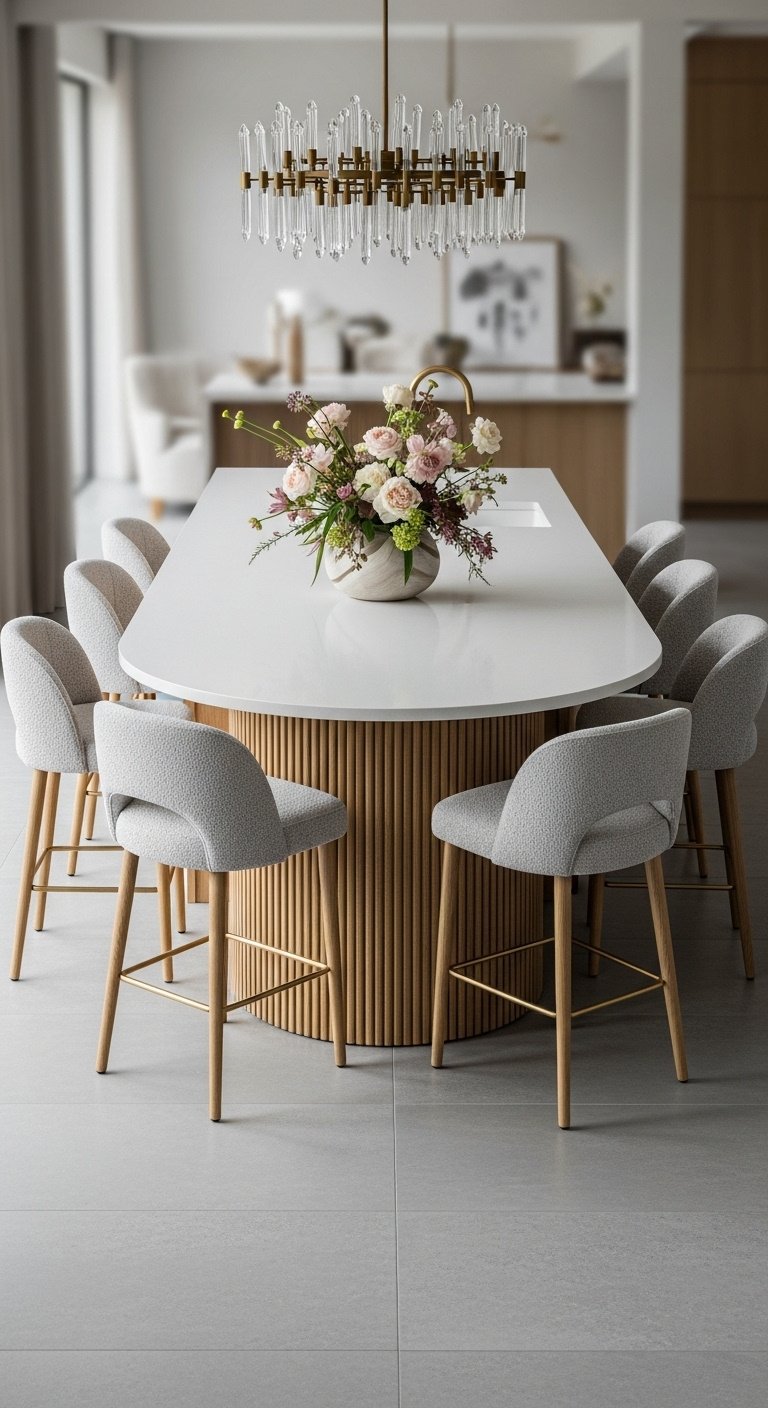
Break away from the traditional rectangle. A curved or semi-circular island creates a more social and inclusive seating arrangement. Guests can face each other, which encourages conversation, much like a round dining table. This unique shape also eliminates sharp corners, which improves traffic flow and makes the kitchen safer for families with young children.
- Materials Needed: Custom-built curved cabinet base (often requires a skilled carpenter), flexible paneling (like tambour or fluted wood), custom-template countertop, stools.
- Step-by-Step Directions:
- This design almost always requires custom cabinetry to achieve the smooth curve. Work with a kitchen designer or cabinet maker.
- The curved shape naturally encourages conversation as seated guests can see each other more easily.
- The countertop material will need to be templated on-site and custom-cut. Solid surface materials like Corian or engineered stone are excellent choices.
- This is a great option for large, open kitchens where the island can be a true centerpiece.
- The lack of sharp corners improves traffic flow and is safer in a busy kitchen.
Pro-Tip: While stunning, curved islands can be more expensive due to the custom labor involved in both the cabinetry and the countertop fabrication. Factor this into your budget.
Create the ultimate social hub! Save this unique curved island design.
7. The Repurposed Farmhouse Table
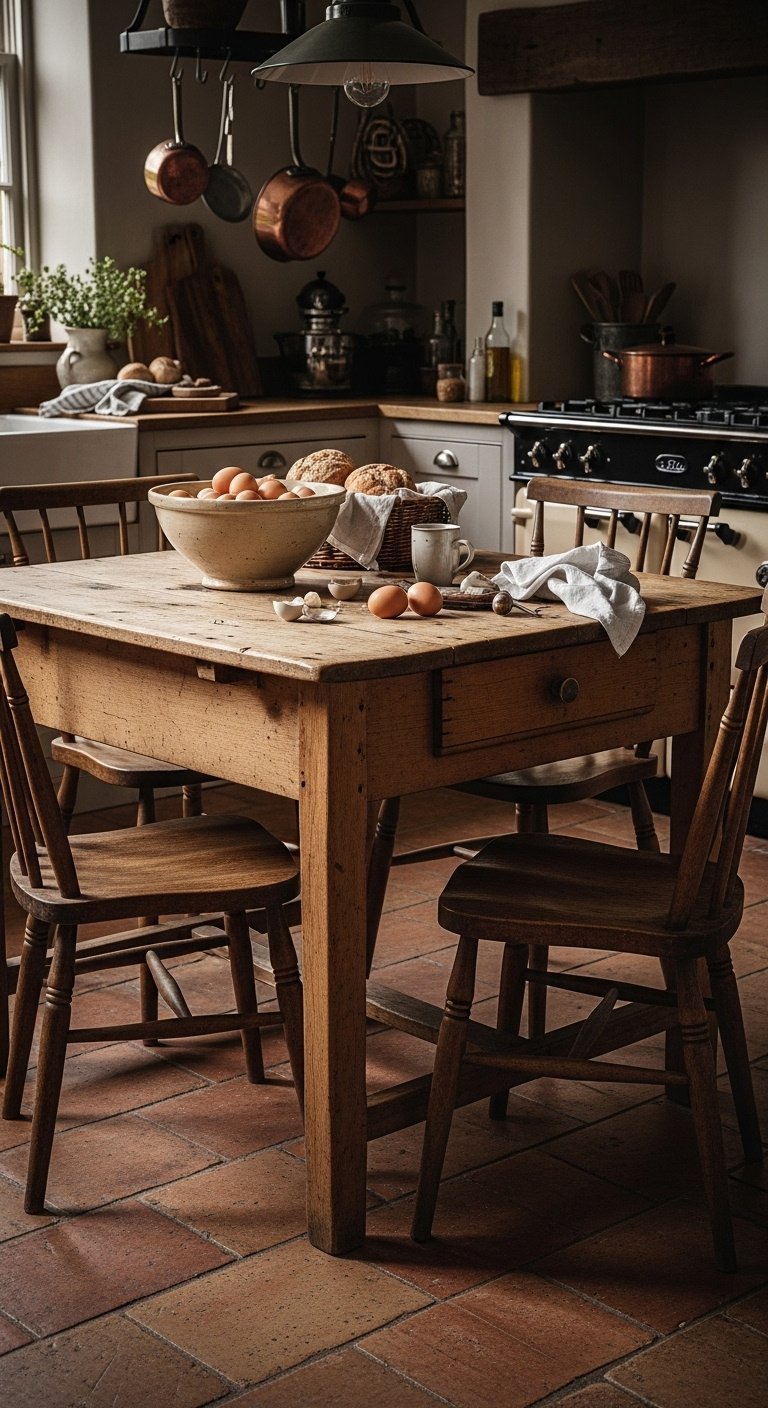
For a touch of character and charm, use a vintage farmhouse table or industrial work table as a freestanding island. This approach adds a collected, unfitted feel to the kitchen, making it feel less like a sterile workspace and more like a warm, inviting room. The open space underneath creates an airy look and provides a natural spot to tuck in chairs or stools.
- Materials Needed: A vintage table (farmhouse, console, or industrial work table), sandpaper, food-safe sealer or wax, chairs or stools.
- Step-by-Step Directions:
- Source a sturdy table from a flea market, antique store, or online marketplace. Ensure it’s the correct height for comfortable work (counter height is ~36 inches).
- Thoroughly clean the table. If the surface is rough, sand it smooth.
- Apply multiple coats of a food-safe wood sealer or conditioner to protect the wood from spills and make it easy to clean.
- Pair with chairs or stools that can be tucked underneath.
- Add hooks on the side for towels or baskets underneath for storage to enhance functionality.
Pro-Tip: Using a piece of furniture instead of built-in cabinetry makes the kitchen feel more like a “collected” room and less like a sterile workspace. It’s a key trend for 2025 and beyond.
Get this character-filled look! Pin this repurposed island idea.
8. The Two-Tone Color Pop Island
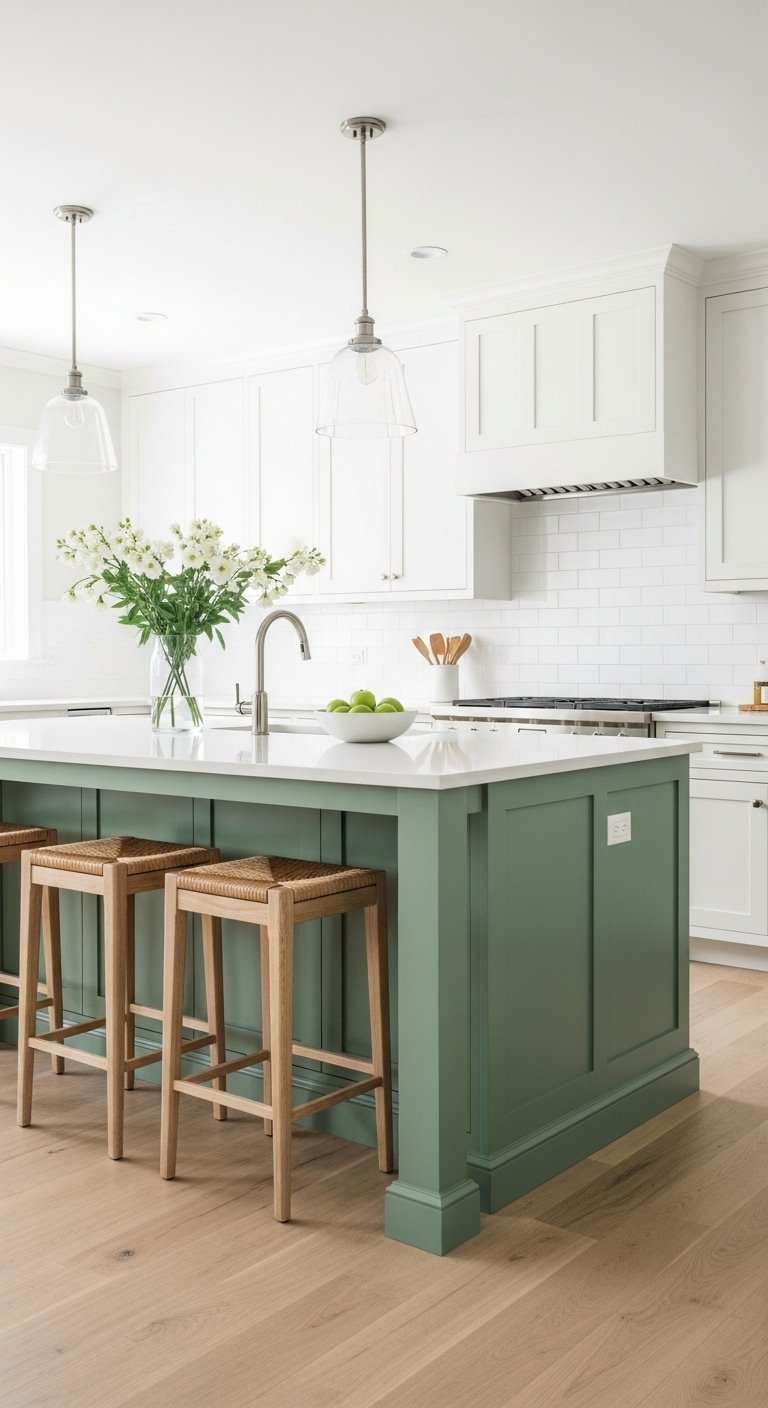
Make your island the star of the show. Painting the island base a contrasting color from your perimeter cabinets is a powerful design move. This two-tone approach instantly creates a focal point and injects personality into your space. A bold sage green, deep navy, or warm charcoal can ground the room and add a layer of sophistication.
- Materials Needed: High-quality cabinet paint (in your chosen accent color), primer, sandpaper, painter’s tape, paint rollers/brushes, countertop, stools.
- Step-by-Step Directions:
- Choose a bold color for the island that complements the rest of your kitchen finishes (floors, perimeter cabinets, backsplash).
- Proper prep is key. Clean the island base thoroughly, lightly sand the surface, and apply a high-quality primer.
- Apply 2-3 thin coats of your chosen cabinet paint, allowing for adequate drying time between coats as per the manufacturer’s instructions.
- Pair the colorful base with a neutral countertop (like white quartz or light butcher block) to let the color be the star.
- Select stools that complement both the island color and the surrounding kitchen elements.
Pro-Tip: Don’t be afraid to go dark! A deep navy, charcoal, or forest green can make an island look incredibly high-end and sophisticated, especially when paired with brass or gold hardware.
Add a splash of personality! Save this two-tone kitchen idea.
9. The Minimalist Console Ledge
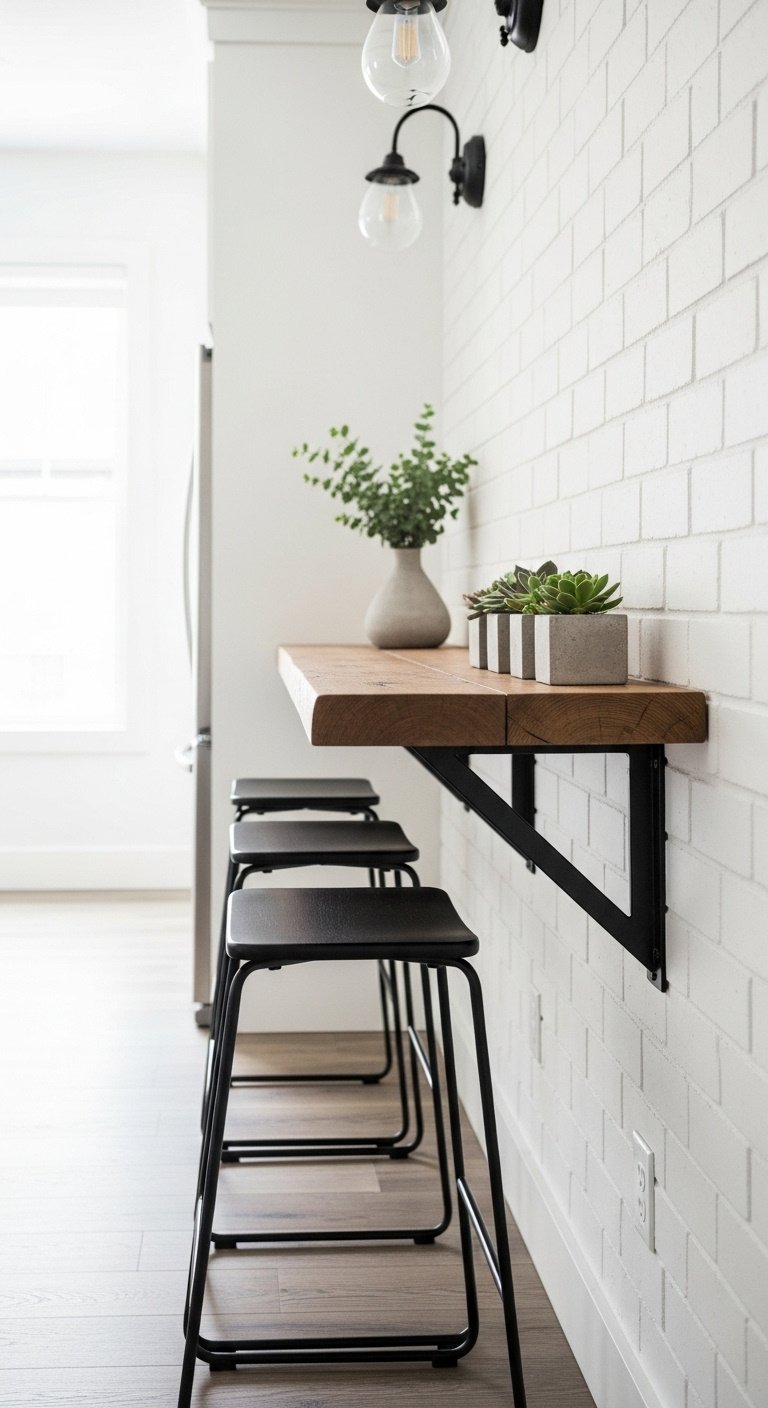
For galley kitchens or extremely narrow spaces, a traditional island is often impossible. A wall-mounted console ledge is a genius workaround that provides seating without obstructing the walkway. This floating “island” creates a sleek, minimalist breakfast bar for quick meals or a morning coffee, taking up minimal physical and visual space.
- Materials Needed: A narrow console table or thick wood slab, heavy-duty wall brackets, lag bolts for wall studs, level, drill, slim stools.
- Step-by-Step Directions:
- Measure your space. A console-style island should be no more than 15-18 inches deep to maintain adequate walkway clearance.
- Locate the studs in the wall where you plan to mount the ledge. This is crucial for stability.
- Securely attach heavy-duty metal brackets to the wall studs at your desired height (counter or bar height).
- Place your console top or wood slab on the brackets and secure it from underneath.
- Choose slim, backless stools that can slide completely under the ledge to keep the walkway clear when not in use.
Lesson Learned: This solution won’t offer much storage, but it excels at adding a functional spot for a morning coffee or a quick meal without visually or physically crowding a small kitchen.
Have a narrow kitchen? This space-saving solution is for you!
Key Takeaways: Your Quick Guide to kitchen island designs with seating
Feeling inspired? Here are the most important points to remember as you plan your perfect kitchen island.
- Function First: Before choosing a style, decide the island’s primary role: food prep, storage, dining, or all three. This will dictate its size and features.
- Measure Everything: Respect the kitchen work triangle and ensure at least 36 inches of clearance around the island for comfortable traffic flow.
- Match Seating to Height: Use standard chairs (18″ seat) for table-height islands (30″), counter stools (24″ seat) for counter-height islands (36″), and bar stools (30″ seat) for bar-height islands (42″).
- Small Spaces Have Options: Don’t rule out an island in a small kitchen. Mobile carts, drop-leaf tables, and narrow consoles are genius solutions.
- Be Bold: Use your island as a focal point. A contrasting color, unique material, or a waterfall edge can elevate the entire kitchen’s design.
People Also Ask About kitchen island designs with seating
What is replacing the kitchen island in 2025?
For 2025 and beyond, the trend isn’t about replacing the island entirely but evolving it. Many designers are opting for freestanding “work tables,” often made of vintage or rustic wood. These pieces feel more like collected furniture, making the kitchen seem more open and less “built-in.” This adds character and an airy feel while still providing a central workspace.
What is the most efficient kitchen layout with an island?
A U-shaped or L-shaped kitchen layout often works most efficiently with an island. In a large U-shaped kitchen, the island fits comfortably in the center without disrupting the work triangle. In an L-shaped layout, the island can form the third side, creating an efficient triangle and often providing a natural separation from a living or dining area.
Is it cheaper to buy or build a kitchen island?
Generally, buying a pre-made, stock kitchen island or a mobile cart is cheaper. A custom-built island costs significantly more due to materials, labor, and features like integrated sinks or appliances. A stock island is a great budget-friendly starting point.
How much space do you need for a kitchen island with seating?
You need a substantial amount of space. Plan for at least 36 inches of clear walkway on all sides of the island. If seating is on one side and it’s a major walkway, 42-48 inches is even better. This ensures people can walk behind someone who is seated and that appliance doors can open fully without obstruction.
Final Thoughts
Your kitchen island is so much more than a countertop; it’s the stage for morning coffee, homework sessions, and conversations with loved ones. By choosing a design that reflects your style and supports your daily life, you’re not just renovating a kitchen—you’re creating the heart of your home. Which of these designs sparked an idea for your own space? Let us know in the comments below.
